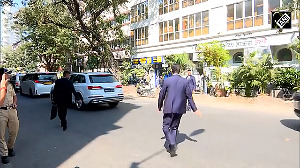 The permeating take-away by a high-powered American delegation of top-notch American educators and researchers which returned from a study-tour of ayurveda in India, was the paucity of an evidence-based approach which is imperative if these ancient herbal remedies were to be incorporated in the US medical curricula.
The permeating take-away by a high-powered American delegation of top-notch American educators and researchers which returned from a study-tour of ayurveda in India, was the paucity of an evidence-based approach which is imperative if these ancient herbal remedies were to be incorporated in the US medical curricula.In interviews with rediff.com, members of the delegation from six major medical schools, including Harvard, Johns Hopkins and Georgetown, said that yet another significant observation was the lack of a formal interaction between allopathic and ayurvedic medicine.
The members of the delegation were Drs David Eisenberg, Director, Osher Research Center and Director, Division for Research and Education in Integrative Medical Therapies, Harvard Medical School; Aviad Haramati, Professor and Director of Education, Department of Physiology and Biophysics, Georgetown University School of Medicine; Anastasia Rowland-Seymour, Assistant Professor of Medicine, Integrative Medicine, Department of Medicine, Johns Hopkins University; Benjamin Kligler, Vice-Chair, Beth Israel Department of Integrative Medicine, Co-Director of Fellowship Programs, Research Director, Continuum Center for Health and Healing and Associate Professor, Department of Family and Social Medicine, Albert Einstein College of Medicine; Victoria Maizes, Executive Director, Arizona Center for Integrative Medicine and Associate Professor, Medicine, Family Medicine and Public Health, University of Arizona College of Medicine; and Anne Nedrow, Associate Professor and Director, Oregon Health and Science University's Center for Women's Health and Primary Care and Integrative Medicine, OSHU School of Medicine.
Leading the delegation was Dr Navin Shah, former president of AAPI and a practising urologist in Maryland, who had put the delegation together after several years of lobbying the government of India to sponsor such a visit so that these experts on complementary and alternative medicines could study the credibility and utility of ayurveda. If convinced, the delegation wanted to consequently bring it into the mainstream of medical research and study in US.
Eisenberg, who recently served as the adviser to the NIH, the Food and Drug Administration and the Federation of State Medical Boards with regard to complementary, alternative and integrative medicine research, education and policy, said, "I was struck by the observation that formal interaction between allopathic and ayurvedic clinical researchers, basic scientist and their respective institutions is limited in India at this point of time."
"One might argue that for a traditional medical system to be thoughtfully, respectfully, yet vigorously evaluated, research must involve both allopathic experts trained in relevant scientific rules of evidence as well as ayurvedic experts trained in all aspects of ayurvedic theory and practice," he said.
Eisenberg, who from 2003 to 2005, served on the National Academy of Sciences Committee responsible for the Institute of Medicine report titled, 'The Use of Complementary and Alternative Medicine by the American Public,' which according to some estimates is a $45 billion industry, said the delegation had suggested that the National Institute of Ayurveda and other Ayurvedic research institutions, consider implementing procedures to establish 'best case series' following the approach adopted by the National Cancer Institute.
He said, "In and when a particular ayurvedic intervention is documented to impact the natural course of a serious disease, this should be noted in a formal 'best case series,'" and that "such observations should be published in international medical journals and these can provide preliminary data to be used in applications for international research collaborations."
Eisenberg said, "Without explicit and substantial documentation, however, anecdotal evidence remains anecdotal and will not attract the attention or support of skeptical international allopathic colleagues."
He also said that the delegation had also "learned of no prospective research documenting the inter-rater reliability of ayurvedic diagnostic procedures nor did we learn of ongoing studies to test the sensitivity or specificity of Ayurvedic diagnostic categories."
"I personally believe that the ayurvedic diagnostic approach has true value and could inform the allopathic community about subgroups of selected patient population," Eisenberg said, and added: "A robust research effort in this domain also seems warranted."
He also said that "with few exceptions, there was little evidence of authoritative, multidisciplinary research involving Ayurvedic medicinal plants, their safety reproducibility, quality assurance, mechanisms of action, efficacy or cost effectiveness in the treatment of common medical conditions."
According to Eisenberg, "There was also little evidence of strategic partnering involving ayurvedic medical experts, Ayurvedic pharmacy experts, botanical authorities across India, agricultural and environmental experts, drug discovery experts, medicinal chemists, clinical trial experts, large pharmaceutical companies, major universities as well as relevant governmental agencies and ministries."
He argued that all of these groups "would need to be working collectively and collaboratively to thoughtfully and rigorously assess the inherent value of ayurvedic medicinal plants."
Kligler said, "One interesting phenomenon we observed that paralleled our experience in the US was a division within the ayurvedic community regarding the need to move to a more evidence-based approach."
"Some of the leading Ayurvedic educators and clinicians were very interested in the idea of developing an evidence-based approach to evaluating the approaches of traditional ayurveda but others felt that the extensive historical evidence of successful treatment of a wide range of conditions should be evidence enough, and that western research methods are not necessarily well-suited to evaluate every aspect of Ayurveda."
Kligler said, "This debate echoes one we have had in the US between and among practitioners and teachers of a number of CAM (complementary and alternative medicines) modalities."
Thus, he argued that "it raises important questions regarding the flaws of our standard research methodologies when they are applied to highly individualized interventions which have multiple components."
Kligler acknowledged that "there was agreement both among the US delegation and among many of the ayurvedic scholars at the meeting that we must work together to develop and test new research methodologies to ore effectively evaluate whole traditional systems like ayurveda."
He said that "the same conversations are taking placed within the integrative medicine community in the US and to some degree even within the NIH.
Haramati, who before leaving had told rediff.com that "my principal interest is to develop a comprehensive training programme for physicians that incorporates all aspects of medicine and health, including elements that are currently considered outside the mainstream," said although the delegation had visited the National Institute of Ayurveda in Jaipur "and had the opportunity to hear numerous presentations about how ayurveda is taught in India, however, I felt we did not come away with enough evidence-based information."
"It was also surprising that we were not provided with any significant scholarly papaers published in known scientific journals in the United States or elsewhere," he added.
Echoing Eisenberg's observations, Haramati also said it was his "impression that a chasm currently exists between ayurveda practitioners and allopathic physicians, which impedes progress towards full integration. Some ayurveda practitioners question why evidence should be provided for therapies that have been practiced for thousands of years."
"On the other hand," he said, "some allopathically-trained clinicians are so skeptical of ayurvedic approaches that they refuse to even submit some therapies to scientific testing and rigor."
Rowland Seymour, said, "While some of the presentations were intriguing and very useful to know in our education on ayurveda, they were perhaps not the best selections for proposals for joint research, as they were not applicable in our population or the intervention proposed would not comply with US standards of care."
She too said that 'one of the major agreements from the delegation was the need to build bridges between allopathic and ayurvedic physicians in India," and added, "We thought it was particularly important to put effort into funding and supporting physicians who would act as bridges between the allopathic world and Ayurveda."
Meanwhile Eisenberg said, "It would be useful for the Indian government working with universities and established survey research centers to conduct national, random surveys in order to document the prevalence, patterns of use, and costs relating to Ayurvedic medicine in India today.
He said similar research in the US, Canada, Australia, Great Britain and the majority of European countries "has informed their respective governments of these important facts and guided their prioritization of research."
Eisenberg said, "This may be a useful strategy for India at this particular juncture. Moreover, if these national surveys are implemented authoritatively, they will simultaneously provide a snapshot of how the adult and pediatric populations of India preferentially seek out allopathic or Ayurvedic medical techniques, the order in which they seek these treatments and perceptions about each, and the degree to which allopathic physicians are informed of patients' ayurvedic medicinal use."





